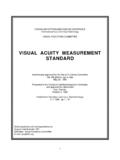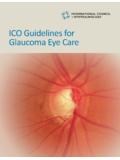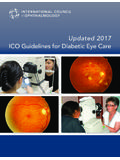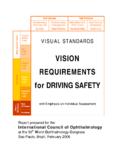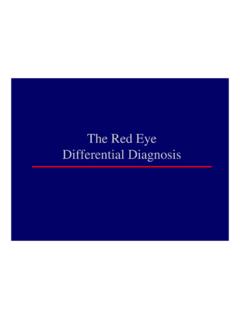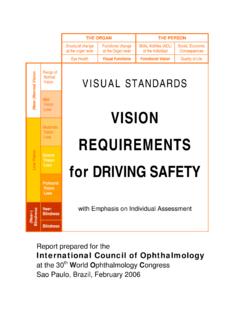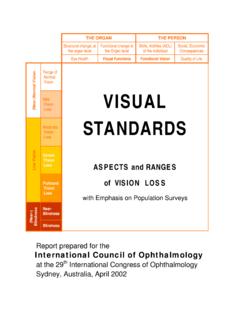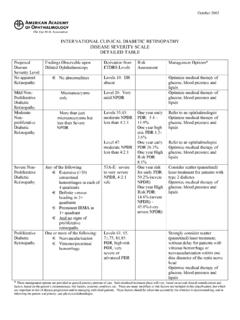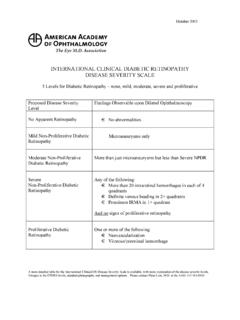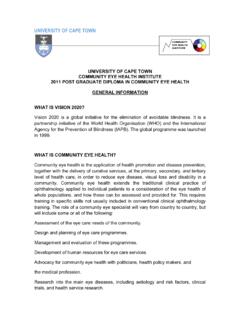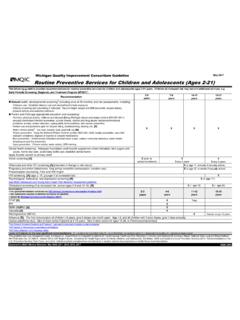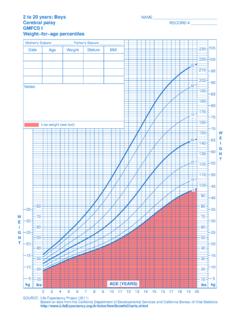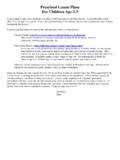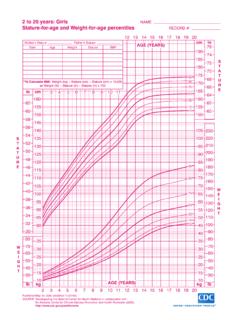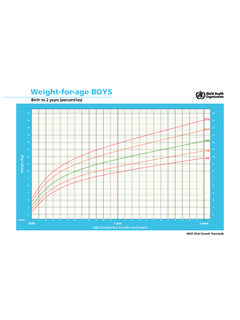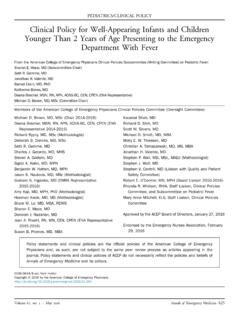Transcription of Age-Related Macular Degeneration (Management …
1 Age-Related Macular Degeneration ( management recommendations ). (Ratings: A: Most important, B: Moderately important, C: Relevant but not critical Strength of Evidence: I: Strong, II: Substantial but lacks some of I, III: consensus of expert opinion in absence of evidence for I & II). Treatment recommendations and Follow-up Plans for Age-Related Macular Degeneration Diagnoses Eligible for Recommended Treatment Follow-up recommendations Treatment Observation with no medical or No clinical signs of AMD As recommended in the Comprehensive Adult Medical surgical therapies (A:I) (AREDS category 1) Eye Evaluation PPP (A:III). Early AMD (AREDS Return exam at 6 to 24 months if asymptomatic or category 2) prompt exam for new symptoms suggestive of CVN. (A:III). Advanced AMD with bilateral subfoveal No fundus photos or fluorescein angiography unless geographic atrophy or symptomatic (A:I).
2 Disciform scars Antioxidant vitamin and mineral Intermediate AMD (AREDS Monitoring of monocular near vision (reading/Amsler supplements as recommended category 3) grid) (A:III). in the AREDS reports (A:I). Advanced AMD in one eye Return exam at 6 to 24 months if asymptomatic or (AREDS category 4) prompt exam for new symptoms suggestive of CVN. (A:III). Fundus photography as appropriate Fluorescein angiography if there is evidence of edema or other signs and symptoms of CVN. Ranibizumab intravitreal Subfoveal CNV Patients should be instructed to report any symptoms injection mg as suggestive of endophthalmitis promptly, including eye recommended in ranibizumab pain or increased discomfort, worsening eye redness, literature (A:I) blurred or decreased vision, increased sensitivity to light, or increased number of floaters (A:III). Return exam approximately 4 weeks after treatment.
3 Subsequent follow-up depends on the clinical findings and judgement of the treating ophthalmologist (A:III). Monitoring of monocular near vision (reading/Amsler grid) (A:III). Diagnoses Eligible for Recommended Treatment Follow-up recommendations Treatment Bevacizumab intravitreal Subfoveal CNV Patients should be instructed to report any symptoms injection as described in suggestive of endophthalmitis promptly, including eye published reports (A:III) pain or increased discomfort, worsening eye redness, blurred or decreased vision, increased sensitivity to light, or increased number of floaters (A:III). The ophthalmologist should Return exam approximately 4 to 8 weeks after provide appropriate informed treatment; subsequent follow-up depends on the clinical consent with respect to the off- findings and judgement of the treating ophthalmologist label status (A:III) (A:III). Monitoring of monocular near vision (reading/Amsler grid) (A:III).
4 Pegaptanib sodium intravitreal Subfoveal CNV, new or Patients should be instructed to report any symptoms injection as recommended in recurrent, for predominantly suggestive of endophthalmitis promptly, including eye pegaptanib sodium literature classic lesions <12 MPS pain or increased discomfort, worsening eye redness, (A:I) disc area in size blurred or decreased vision, increased sensitivity to light, or increased number of floaters (A:III). Minimally classic, or occult with no classic lesions Return exam with retreatments every 6 weeks as where the entire lesion is indicated (A:III). <12 disc areas in size, subretinal hemorrhage Monitoring of monocular near vision (reading/Amsler associated with CVN grid) (A:III). comprises <50% of lesion, and/or there is lipid present, and/or the patient has lost 15 or more letters of visual acuity during the previous 12 weeks PDT with verteporfin as Subfoveal CNV, new or Return exam approximately every 3 months until stable, recommended in the TAP and recurrent, where the classic with retreatments as indicated (A:III).
5 VIP reports (A:I) component is >50% of the lesion and the entire lesion Monitoring of monocular near vision (reading/Amsler is <5400 microns in grid) (A:III). greatest linear diameter Occult CNV may be considered for PDT with vision <20/50 or if the CVN. is <4 MPS disc areas in size when the vision is >20/50. Diagnoses Eligible for Recommended Treatment Follow-up recommendations Treatment Thermal laser photocoagulation Extrafoveal classic CNV, Return exam with fluorescein angiography surgery as recommended in the new or recurrent approximately 2 to 4 weeks after treatment, and then at MPS reports (A:I) 4 to 6 weeks and thereafter depending on the clinical May be considered for and angiographic findings (A:III). juxtapapillary CVN. Retreatments as indicated Monitoring of monocular near vision (reading/Amsler grid) (A:III). AMD = Age-Related Macular Degeneration ; AREDS = Age-Related Eye Disease Study; CNV = choroidal neovascularization; MPS = Macular Photocoagulation Study; PDT = photodynamic therapy; TAP =.
6 Treatment of Age-Related Macular Degeneration with Photodynamic Therapy; VIP = Verteporfin in Photodynamic Therapy * Adapted from the American Academy of Ophthalmology Summary Benchmarks, November 2010. ( ).
